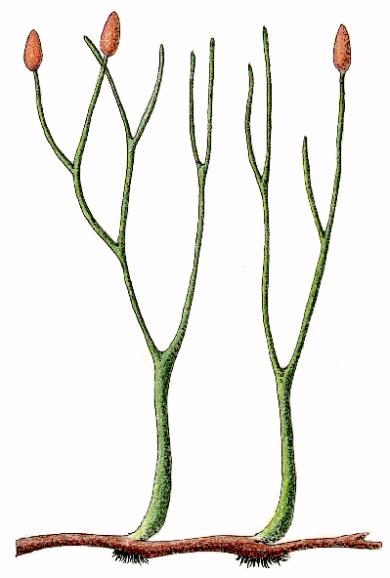| The first plants were algae and these still thrive in a range of aquatic habitats today. (Do not fall into the trap of thinking because algae have been around for so long they are "primitive". Look upon them instead as being simple compared to more complex groups. The fact is algae today are themselves highly evolved and well adapted to the niche they occupy.) |
The land plants evolved from the algae, more specifically green algae, as suggested by
certain common
biochemical traits;-
| Reserves: starch |
|
| Cell wall: based on cellulose microfibrils |
|
| Photosynthetic pigments: Chlorophylls a & b with accessory pigment
ß-carotene |
In view of the relatively stable nature of an aquatic environment what would be the selection pressure favouring algae which could survive on the land? Probably competition!
What kinds of problems would such pioneer plants have faced?
| Desiccation - the plants would dry out |
|
| Water for reproduction - even if there was sufficient water for survival they
would need free water for fusion of gametes |
|
| Support - buoyancy supports and spreads the algal thallus. These plants would
now be plastered on the mud |
|
| Water for spore dispersal - to colonise new terrestrial habitats spores would
have to be released in air not water |
The hypothesis is that some 400 million years ago freshwater, green,
filamentous algae invaded the land. These probably had an isomorphic alternation of generations and were
probably heterotrichous.
| gametophyte | sporophyte | |
Imagine then, within a population of such algae, individuals more able to withstand periods without submergence. Such individuals which could survive at the pond margins on the wet mud would be selected.
Gametophytes would need water for reproduction - the basal part of the gametophyte developed with loss of the upper portion. A sterile jacket of cells evolved to protect the developing gametes during periods of exposure.
Sporophytes - spore dispersal was originally in water. Spores now need to be dispersed in air. The upper spore-bearing part of the plant would need to be held above water, this involved several changes.
The generations began to diverge.
| gametophyte | sporophyte | |
Sporophyte changes
| Cuticle - a new non-cellular, waxy, water-proof layer, the cuticle,
evolved on the surface of the entire sporophyte. This minimised desiccation . |
|
| Sporopollenin - a similar waxy waterproofing appeared on the surface of spores and prevented them drying out as they travelled in the air. | |
| Multiaxial filament - this form rather than a flimsy uniaxial filament
would provide for an erect plant. Even when the outer cell layers lose water the cells at
the core would still be turgid. |
|
| Transport system - with the increased bulk of the sporophyte, simple diffusion
would no longer be adequate - evolution of the stele, i.e.
xylem and phloem for transporting water, minerals and organic material. |
|
| Ventilation system - this increased bulk also meant gas exchange across the
plant surface and within the sporophyte would have become problematic. The evolution of
stomata -pores in the plant surface - and intercellular air spaces solved this. |
|
| Basal portion - the lower portion of the sporophyte attained a role of anchorage. It became little more than a few thread-like rhizoids. |
In the early 1900's, in a quarry in Rhynie,
Scotland, fossils were found which very much fit the picture for the
sporophyte just described. This plant was given the name Rhynia.
 |
Rhynia thrived in the Devonian, about 400 million years ago. It had erect
dichotomously branched stems with sporangia borne at the tips. It spread by an underground
rhizome bearing rhizoids. The booklet, Plants Invade the Land, describes Rhynia at length. Drawing of Rhynia sporophyte by Francoise Gantet |
| Rhynia
was superficially very similar to another extinct plant
Aglaophyton.
Both had stomata and waterproofed spores but the latter did not have true vascular tissue
and was bigger. These fossil plants showed evidence of an alternation
of generations. Since then other Rhyniophytes have been described. On of these, Cooksonia, predates Rhynia. It thrived in the Silurian period and is similar in form to Rhynia. These were the first plants to conquer the land. Let's look at these early land plants. |
| Interestingly, there is a group of plants - the whisk ferns - which resembles Rhynia. Psilotum nudum which grows in moist, shady habitats in the Caribbean is such a plant. At one time, Psilotum was thought to be a surviving relative of Rhynia. It is, however, more generally thought to be a Fern Ally, related to the Ferns, with loss of features such as leaves and roots. |
Recent views on the early evolution of land plants suggest some modifications may become necessary to the hypothesis outlined above;-
|
Green Charophytic algae, as exemplified by Chara at right,
show some features of land plants.
|
In Barbados, Chara is common in Graeme Hall Swamp. |
| Would you
like to look at some sample questions on this part of the course? If so, click the button. |
| We have
now completed our look at the first land plants. Click the button to move on to the Bryophytes. |
![]() .
.
© C. M. Sean Carrington 1997
Last modified 22 August, 2000.